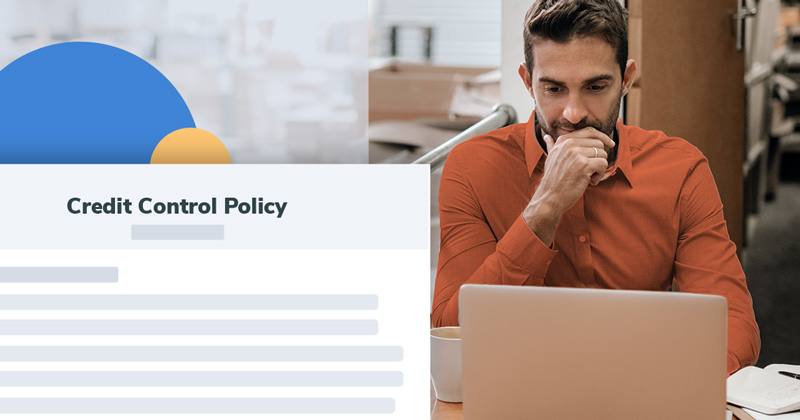Those calls from companies asking for payment can be uncomfortable and unpleasant. The fact is, though, most people will pay their outstanding bills only when reminded to do so. And sometimes, not even then.
From a business perspective, an effective credit control system is critical to maintaining a healthy cash flow. A well-run and stable company relies on regular payments from their debtors to stay afloat, especially in these turbulent times.
What is credit control? What are the benefits of having a working system in place? What should you know about extending credit and managing payments?
What is credit control?
Credit control is a process used by businesses to monitor and review accounts with other organisations or individuals. The main goal of credit control is to maintain good business relationships and provide accurate information about the status of an account.
Credit control can also be defined as a strategy that promotes the selling of goods or services through the extension of credit to potential customers in an effort to maximise sales. At its most basic level, businesses prefer extending credit only to those with “good” credit and limiting it for others who might have a history of financial delinquency.
Credit control systems can be called many different things including credit management, credit policies, or debt-collection strategies. Whatever you know it as, it's all about getting the money in regularly.
The role of a credit controller
The credit controller is the liaison between a company and an individual or another business. They are responsible for recovering any unpaid money that's owed, as well as checking up on new requests of potential customers so they can judge how much credit should be given before approving it.
Credit controllers also get input into when debtors are allowed goods and services from these businesses, which includes helping decide whether legal proceedings should commence if someone has paid late!
These people and their teams walk the fine line between recovering money, granting credit to lower-risk customers, and maintaining healthy business relationships.
Key duties of a credit controller
The responsibilities of a credit control officer start right at the beginning of the business relationship.
Their duties will include:
- Assess and review requests for credit
- Manage and enforce the terms of credit
- Follow up on late payments
- Resolve queries and complaints relating to credit
- Proactively manage the payment collection process
What are the benefits of credit control policies?
The company has the option to decide on which type of credit control policy it wishes to implement. There are three main types: restrictive, moderate and liberal, and these exist with different risk strategies for each one.
Whilst credit control factors vary from business to business, there are some that remain constant.
- What credit period will be offered to the customer?
- Will you offer cash discounts and if so, on what terms?
- What credit score will you require as a minimum qualification for credit?
- What collection policy will you implement?
Whatever choice your business makes, implementing these policies comes with a host of benefits. Consider just a few:
Getting paid faster
With a firm credit policy in place and a robust invoicing system operating quietly in the background, you will certainly enjoy faster payments. Not only will this assist with a healthy cash flow, but it will enable you to pay your suppliers faster - possibly making use of early payment discounts.
The anxiety of ensuring funds are available for salaries, suppliers, or tax payments will not pose a problem for you.
Reducing bad debt
We know that we will never eliminate bad debt completely. However, we can put the checks and balances in place to ensure that we minimise the risk of delinquent customers.
A good credit policy will weed out the undesirable customers in the first instance while maintaining tight control on the payment cycle of existing customers. It's a fact that the longer an amount is outstanding, the lower the chances of payment. So, getting in early and closely monitoring customer payment habits is essential.
We know that we will never eliminate bad debt completely. However, we can put the checks and balances in place to ensure that we minimise the risk of delinquent customers.
Expanded customer base
Depending on how your business is positioned in the marketplace, you may want to consider a more liberal approach to your credit policies that may attract new customers.
To be fair, these past few years have been incredibly difficult for many and in some cases, through no fault of their own. A more relaxed approach may entice customers to your business and offer a fresh new revenue stream.
Manage cash flow
The credit terms that you offer to your customers should align with your business requirements. Is the business liquid enough to carry a customer invoice for 30 or 60 days? Younger businesses need to weigh this up carefully and work out the timing of money in versus money out.
A poor cash flow due to late-paying customers may impact your own creditworthiness, affect staff salaries, and interrupt your business flow.
Key tips for an effective credit control policy
It'd be nice if your credit management process took care of itself, but that's not realistic. Like with your personal finance, you need to develop a robust strategy for collecting payments that'll help you to get paid faster. Most businesses only invest in a credit control team after they've failed to receive timely payments, which can adversely impact their long-term success. By taking a proactive approach to effective credit management, businesses can collect payment and ensure timely payment.
Below, we'll run through some handy tips for managing credit, which will lighten the burden on your accounting department, help to avoid bad debts, lead to higher sales, and make it easier to collect payments.
Develop your approach
Standardisation of your payment terms, how you'll allocate credit to customers, your credit limits, and how you'll manage customer accounts will make things much easier for your accounts receivable team. Several factors will influence how you put together your credit control policy, including the type of products/services you offer, but the main goal remains the same: outlining how you'll invoice, how you'll chase missed payments, and the types of payment plans you'll offer to non-paying customers. It's best to conduct periodic reviews of your approach, and make adjustments when necessary.
Get customer details
You'll be less likely to be paid at all, let alone on time, if you allocate credit to customers with poor credit history. As such, performing checks to learn a customer's credit risk before you assign credit is a smart way to ensure your businesses financial health. Ultimately, if they have good credit history, they'll be much more likely to pay. Businesses offer credit to individuals with bad credit at their risk. With Chaser, you can use the credit checks feature to make informed decisions about whether to extend credit to a potential customer.
When to say no
You'll want to show goodwill to your clients, but if their credit standards are slipping, and it's beginning to impact your financial statements, then that is a clear metric that it may be time to cut them off. A customer shouldn't have the right to purchase goods if they're repeatedly using various methods to avoid paying. Chaser includes a 'paying rating' feature that allows you to identify non-paying or problematic clients.
Invoice promptly
Many businesses and individuals will only pay their money-owed when they receive an invoice. To ensure they pay as soon as possible, make sure that you're sending your invoices as soon as possible. It's a proactive process that gets the ball rolling immediately, one that can lead to increased profits and better client relationships.
Outline your terms and conditions
The sales price isn't the only thing you should include on your invoices. You should also include information on how to pay, when the cash is due, any interest that may be charged for late-payment, how it may impact their credit limits, and any other relevant information. By outlining your payment terms directly, you'll be ensuring that customers know it's in their best interest to pay promptly.
Stay Friendly
Chasing money can be frustrating, but it's best to maintain a positive attitude. There are a number of reasons why people pay later than you'd like them to. By ensuring the relationship is kept civil, you can increase your chances of getting paid and of making more sales in the future.
Offer a variety of methods
You'll make it much easier for individuals to pay their invoices if you offer a variety of ways to pay. Some people like to pay via the central banks; others like to pay with debit cards; and others like to pay via online tools such as PayPal. Speak with your credit manager to see how many methods your organisation can offer. Chaser offers a handy payment portal that removes most barriers for invoice paying.
Stay diligent
Knowing the credit control definition is all good and well, but at some point, you'll come up against a non-paying individual or organisation. And the longer that non-payment drags, the less likely it is that it'll be paid. With Chaser, you'll have a variety of tools that you can use to chase unpaid invoices, including via personalised emails and SMS messages.
Should I outsource credit control?
It's clear that credit control is not something that can be left to chance. This is why so many businesses choose to outsource their credit control responsibilities. You may feel a little nervous handing over client relationships and company debt to an outside company, but there are some key benefits that can't be overlooked.
An outsourced credit control function frees up your accounting and customer service team to focus on their role, instead of chasing payments from errant customers. A time-consuming task for sure. A professional company will already have solid practices in place, alongside a host of experience in this exact area which relieves you of the burden. The stress of managing customer queries, invoicing, chasing aged debt, and the day-to-day requirements or credit control will be a thing of the past.
If you would like to maintain a level of control over your customer relationships but are fed up with the lengthy credit control procedures, then you also have the option of using credit control automation tools.
So, what is credit control?
It is an essential part of mitigating risk, choosing who you will extend credit to, and managing the process to ensure that your business is always in the black.
Still got questions? Book a demo and see how we can assist you.




